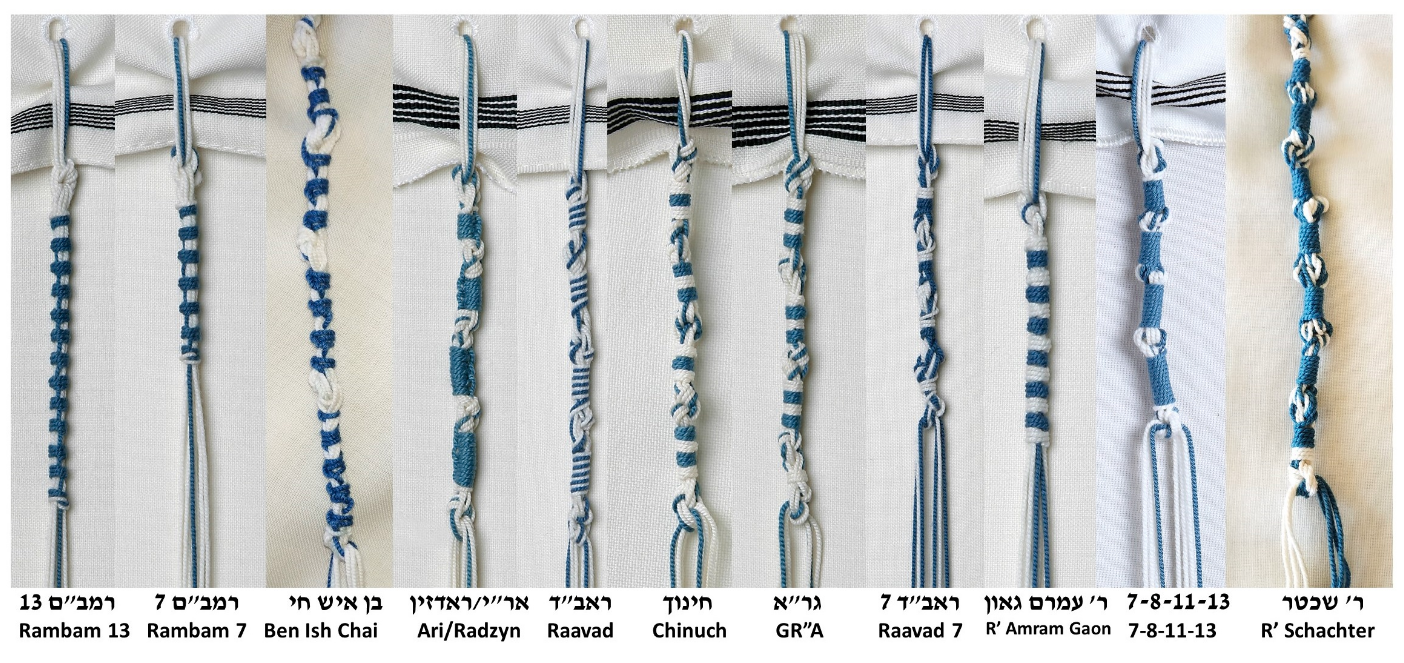Techelet Tzitzit Tying Customs
Often tallit buyers who opt for techelet for the first time are unsure about the various tying customs.

For Sephardim, we follow Ptil Tekhelet Association's recommendation that they adopt the Rambam tying custom, also known as Yemenite tzitzit. Rambam/Yemenite tying can be done with either 7 chulyot or 13 chulyot (scroll to bottom). The traditional Sephardic tying custom used for all-white tzitzit is not recommended for techelet. Some Sephardim opt for Ben Ish Chai tying, which is similar to Chabad/Arizal tying, but with a spiraling ridge, and more spacing between the chulyot.
For Ashkenazim we usually tie techelet either according to the Arizal, which looks much like regular Ashkenazi tzitzit tying with a 7-8-11-13 windings pattern, or else according to the Vilna Gaon (aka "Gra") or Sefer HaChinuch.
Vilna Gaon and Sefer HaChinuch tzitzit look quite similar, with alternating segments of white and blue chulyot throughout. With the Arizal tying custom, almost all of the twists are blue.
Also, according to the Arizal you wind up with seven white strings and one blue string, whereas with the Vilna Gaon (Gra) and Sefer HaChinuch, you end up with six white and two blue.
A further option is the Raavad tying custom, which alternates white-blue throughout, broken up by five double knots, much like the Ashkenazi 7-8-11-13 custom for white-only tzitzit.
Note that the term "Raavad" can be somewhat confusing, because when sold separately, Ptil Tekhelet tzitzit strings come in two versions: Rambam and Raavad. The Rambam type is used not only to tie Rambam, but also Arizal (sometimes referred to as "Radzyn" or "Chabad"), and likewise the Raavad type is used to tie not only Raavad, but also Vilna Gaon, Sefer HaChinuch and other customs.
Another option is Tosafot (labeled "Raavad 7" in the photo below), which uses two full strings of blue on each corner, and consists of just seven chulyot. Because this approach uses twice as much techelet, the cost is considerably higher.
A further option is Amram Gaon, which is a very straightforward approach of 13 chulyot tied in a single unbroken section, with a standard double knot at the top and a tucked knot at the bottom.
In addition to the tying custom, another issue is the ratio of blue strings to white strings. The Torah stipulates that we always tie four strings on each corner. When tied, you see what appears to be eight strings hanging loose. There is a debate in the Rishonim how many of those eight strings should be blue (techelet).
Rambam - one blue, seven white
Raavad - two blue, six white
Tosafot - four blue, four white
Note that these terms can be somewhat confusing, because you can follow the Rambam's approach regarding the ratio of blue to white strings, but not tie according to the Rambam tying custom. Likewise, you can follow the Raavad's opinion to have two blue strings and six white, yet not tie those strings according to the Raavad tying custom.
Our standard policy is as follows:
If you select Sephardic, Ben Ish Chai, Rambam/Yemenite or Chabad/Arizal tying, we use one blue string and seven white strings (Rambam).
If you select Ashkenazi, Breslov, Sefer HaChinuch, Vilna Gaon, Raavad or Amram Gaon tying, we use two blue strings and six white strings (Raavad).
If you would prefer a different ratio (e.g. Arizal with two blue strings), please note your request during checkout.
The above is for Murex Techelet (a.k.a. Ptil Tekhelet). If you select Cuttlefish Techelet strings (a.k.a. Radzyn), we always use two blue strings and six white strings (Raavad), even for Rambam/Yemenite tying.
 United States Dollar
United States Dollar
 Shekel
Shekel
 Euro
Euro
 British Pound
British Pound
 Australian Dollar
Australian Dollar
 New Zealand Dollar
New Zealand Dollar
 Canadian Dollar
Canadian Dollar
